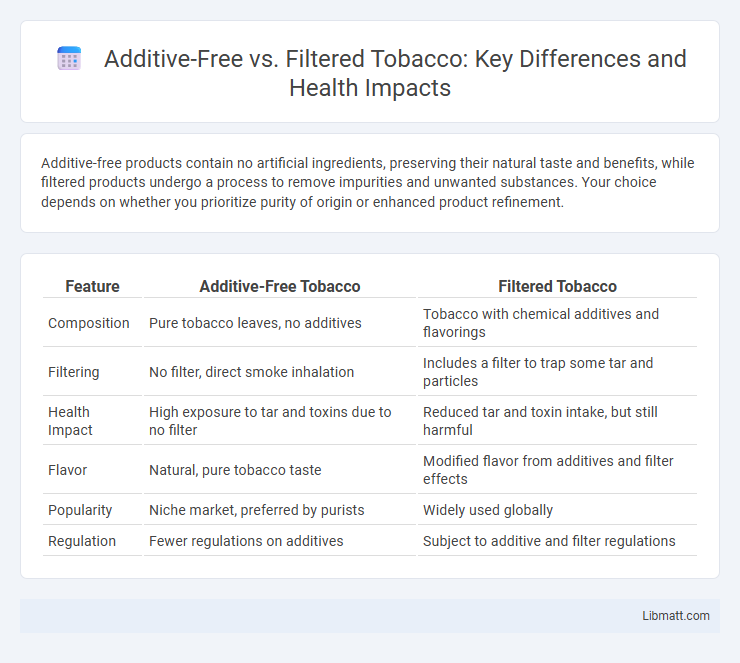Additive-free products contain no artificial ingredients, preserving their natural taste and benefits, while filtered products undergo a process to remove impurities and unwanted substances. Your choice depends on whether you prioritize purity of origin or enhanced product refinement.
Table of Comparison
| Feature | Additive-Free Tobacco | Filtered Tobacco |
|---|---|---|
| Composition | Pure tobacco leaves, no additives | Tobacco with chemical additives and flavorings |
| Filtering | No filter, direct smoke inhalation | Includes a filter to trap some tar and particles |
| Health Impact | High exposure to tar and toxins due to no filter | Reduced tar and toxin intake, but still harmful |
| Flavor | Natural, pure tobacco taste | Modified flavor from additives and filter effects |
| Popularity | Niche market, preferred by purists | Widely used globally |
| Regulation | Fewer regulations on additives | Subject to additive and filter regulations |
Understanding Additive-Free and Filtered: Key Differences
Additive-free products contain no artificial substances, preservatives, or chemicals, ensuring purity and a natural experience, while filtered items undergo processes to remove impurities or contaminants for a cleaner taste or appearance. Your choice between additive-free and filtered depends on whether you prioritize natural content or enhanced clarity and safety. Understanding these key differences helps you make informed decisions about product quality and health impacts.
The Composition of Additive-Free Products
Additive-free products consist solely of natural ingredients without artificial preservatives, colorings, or flavor enhancers, ensuring purity and authenticity in their composition. These products often retain the original nutritional profile and flavor complexity, appealing to consumers seeking natural alternatives. Choosing additive-free options supports your preference for cleaner, minimally processed foods free from synthetic additives.
What Are Filtered Products?
Filtered products undergo a process that removes impurities, contaminants, and unwanted particles to improve purity and safety, enhancing their overall quality and taste. This filtering can involve physical methods such as charcoal or mechanical filtration, targeting elements like sediments, toxins, or microorganisms. The primary goal of filtered products is to deliver a cleaner, more refined experience without introducing any additives or altering the natural composition significantly.
Health Implications: Additive-Free vs Filtered
Additive-free products eliminate exposure to synthetic chemicals, reducing potential health risks like allergic reactions and hormonal disruptions. Filtered options may remove harmful substances such as toxins and impurities, promoting safer consumption and better overall health. Your choice impacts how much artificial exposure or contaminants you introduce into your body, influencing long-term wellness.
Taste Profile Comparison: Additive-Free vs Filtered
Additive-free products offer a pure, unaltered taste profile that highlights natural flavors and aromatic nuances, while filtered options often present a smoother, more refined flavor by removing impurities and harsh elements. You may notice that additive-free choices retain bold, complex notes that appeal to connoisseurs seeking authenticity, whereas filtered variants deliver consistency and a cleaner finish ideal for everyday consumption. Comparing both reveals how filtration processes impact flavor intensity and mouthfeel, influencing your sensory experience.
Environmental Impact of Both Options
Additive-free cigarettes produce fewer chemical byproducts, reducing environmental toxins compared to filtered options that typically contain plastic-based filters contributing to microplastic pollution. Filtered cigarettes generate significant waste, with billions of non-biodegradable filters discarded worldwide each year, posing risks to wildlife and ecosystems. Your choice between additive-free and filtered cigarettes directly influences the extent of environmental harm caused by toxic waste and litter accumulation.
Popular Brands: Additive-Free and Filtered Choices
Popular additive-free cigarette brands like American Spirit and Nat Sherman emphasize natural tobacco without chemical additives for a pure smoking experience. Filtered cigarette options from brands such as Marlboro and Camel offer a balance of flavor and reduced tar intake through advanced filtration technology. Your choice between additive-free and filtered cigarettes depends on your preference for natural tobacco versus enhanced filtration and taste consistency.
Price Differences Explored
Additive-free cigarettes generally cost more than filtered varieties due to their organic or natural production processes and premium ingredients that avoid chemical additives. Filtered cigarettes benefit from mass production and additives that lower manufacturing costs, making them more affordable for consumers. Price differences reflect the perceived health benefits and quality, with additive-free options targeted at niche markets willing to pay a premium.
Consumer Preferences and Market Trends
Consumer preferences increasingly favor additive-free products due to growing awareness of health and natural ingredient benefits, driving demand in niche markets such as organic and clean-label categories. Filtered products maintain strong market presence, particularly in regions where traditional taste and smoothness are prioritized, balancing consumer expectations for quality and convenience. Understanding your preference for additive-free or filtered options can help navigate evolving trends and select products aligned with lifestyle choices and health concerns.
How to Choose: Additive-Free or Filtered?
Choosing between additive-free and filtered options depends on your preference for purity versus smoothness. Additive-free products offer a natural, unaltered experience preserving original flavors, while filtered versions provide a cleaner, refined taste by removing impurities. Assess your taste priorities and health considerations to determine whether additive-free authenticity or filtered clarity best suits your needs.
Additive-free vs Filtered Infographic

 libmatt.com
libmatt.com